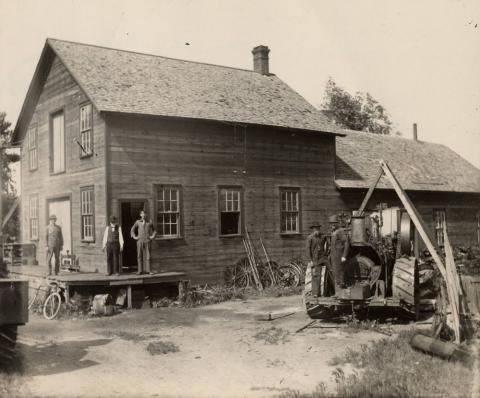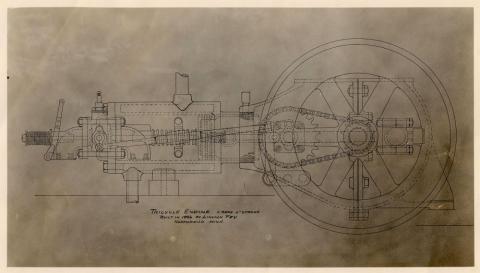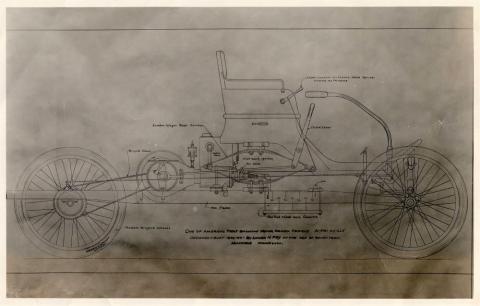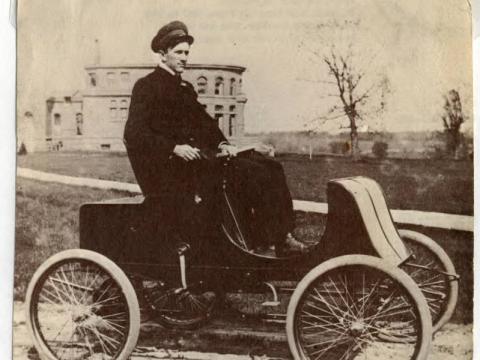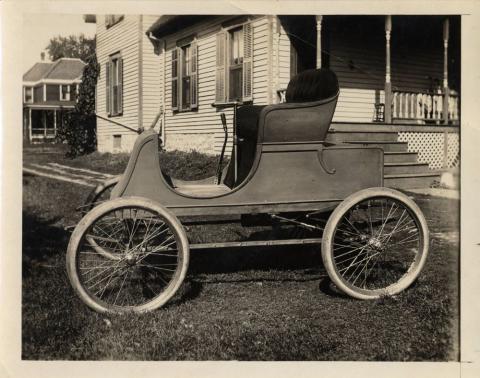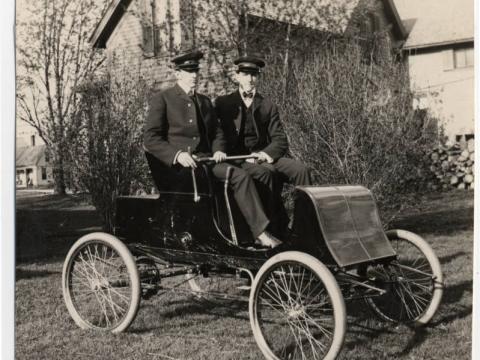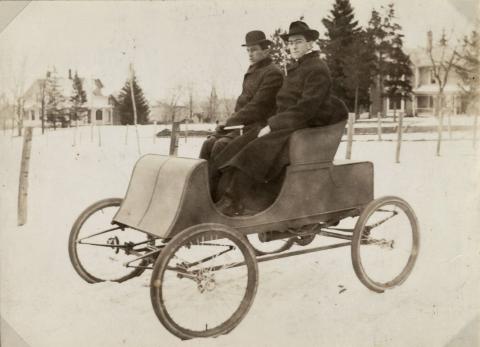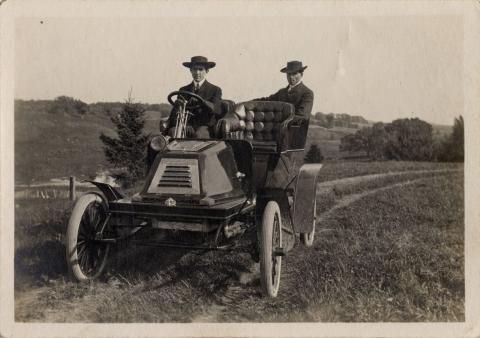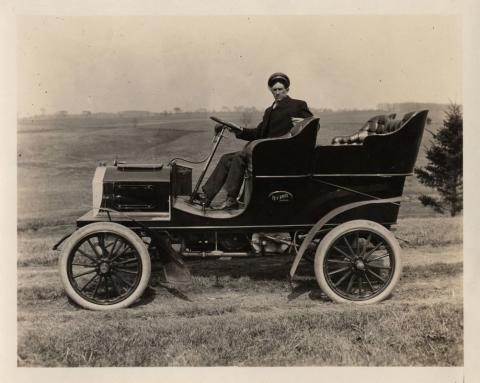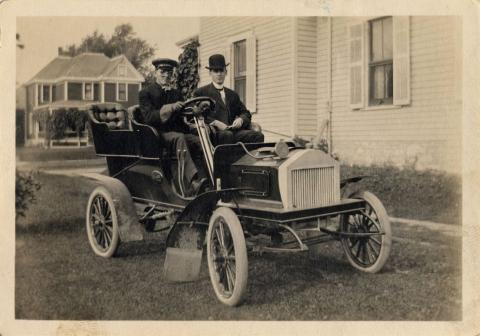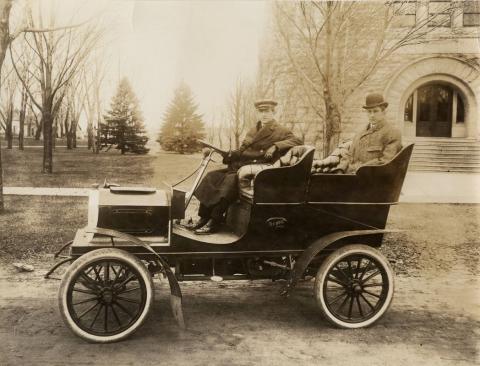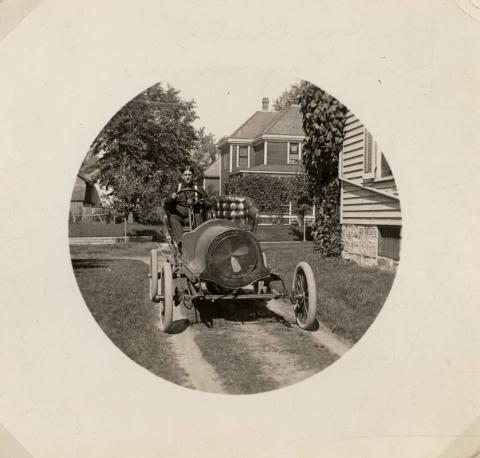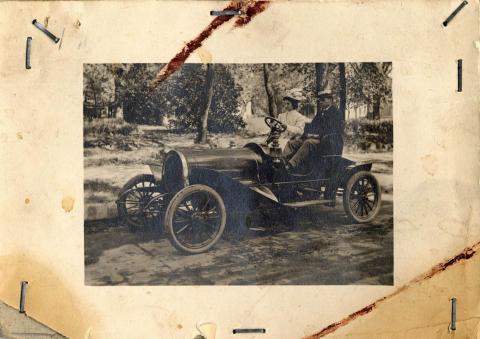Primary Source Set
by Stephanie Hess, Digital Curator, Minnesota Digital Library
People of Minnesota Transportation
In the late 1800s, a new type of “horseless carriage” started sharing the streets with horses, wagons, bicycles, and pedestrians. Inventors across Europe and America began to develop this new type of vehicle that used a gasoline or electric-powered engine. Each custom-built experimental automobile built on emerging and exciting new technologies.
In 1896, 15-year-old Lincoln Fey was inspired to build one of these new vehicles in his family barn in Northfield, Minnesota. He invented a gasoline engine to power this first automobile, which ran on three tandem-bicycle wheels (one in the back and two in the front). He and his brother Frank successfully test-drove the car in 1897 and later described that moment as “one of the most thrilling moments of our lives.”
After selling the first machine for $65, Lincoln and Frank began making plans for a new automobile. By late 1898, they were ready to test drive their second car through the streets of Northfield. They waited until nighttime so they did not bother their neighbors and drove for about three hours straight. Lincoln later wrote how they “got quite a kick out of the fact that people the next day were having considerable trouble getting information as to what that thing was going around town last night.” This car sold for $175.
The Fey brothers continued improving their automobile designs and engines. In 1903, they built their third car with an air-cooled engine, steering wheel, and two rows of comfortable leather seats. By 1906, they had completed their fourth and final car, which had a distinctive fan-cooled four cylinder engine. After selling this vehicle, the brothers never built another car, though nobody knows the reason why. Lincoln Fey spent the rest of his life as a mechanic and inventor in Northfield.
Soon after the Feys stopped making automobiles, Henry Ford introduced the Model T and later perfected the mass-production of cars in America. Although the Fey brothers are a footnote in the history of automobiles in America, these innovators exemplified this period of inventiveness and experimentation that led to the modern American automobile.
Discussion Questions & Activities
- Early automobile builders like the Feys are often described as inventors, rather than businessmen. Do you agree? Why or why not?
- Why were these early automobiles considered toys and novelties for rich people?
- Take a closer look at Car No. 1, Car No. 2, Car No. 3, and Car No. 4. What similarities do you notice in all of the cars, and what parts are not the same? Why is each car different?
- Make a list of the benefits of horse-powered transportation, and another listing its drawbacks. Do the same for horseless automobiles. Comparing the pros and cons, which mode of transportation do you think is better?
- Is an automobile a luxury or a necessity? Does it meet peoples’ wants or needs? Would your answers be different 100 years ago? If so, what changed?
- Why do you think Lincoln and Frank Fey only built four cars? Would you have done the same?
- Name one thing that surprises you about these early automobiles and explain your reasoning.
- Consider how the people of Northfield might have reacted to this noisy new invention in their town. Why would they feel this way? How would you feel about it in their place? Would you have been excited or terrified (or both)?
- Look at the final photograph in this set, with a woman behind the wheel of Lincoln Fey’s last car. How did automobiles affect women in Minnesota in the early 20th century?
- How did automobiles change America? Consider things like town planning, infrastructure, parking garages, shopping behaviors, urban growth and change, development of suburbs, etc.
eLibrary Minnesota Resources (for Minnesota residents)
"Automobiles." In 1900-1909, edited by Judith S. Baughman, Victor Bondi, Richard Layman, Tandy McConnell, and Vincent Tompkins. Vol. 1 of American Decades. Detroit, MI: Gale, 2001. Gale In Context: High School (accessed May 10, 2022).
"Automobiles." In Gale In Context Online Collection. Detroit, MI: Gale, 2020. Gale In Context: High School (accessed May 10, 2022).
"Automobile, gasoline." In World of Invention. Gale, 2006. Gale In Context: High School (accessed May 10, 2022).
"Automotive industry." Britannica School, Encyclopædia Britannica, 25 Jan. 2024. Accessed 6 Oct. 2025.
Flink, James J., and Christopher Wells. "Automobile." In Dictionary of American History, 3rd ed., edited by Stanley I. Kutler, 366-371. Vol. 1. New York, NY: Charles Scribner's Sons, 2003. Gale In Context: High School (accessed May 10, 2022).
"The Invention of Automobiles." In Science and Its Times, edited by Neil Schlager and Josh Lauer. Vol. 5. Detroit, MI: Gale, 2001. Gale In Context: High School (accessed May 10, 2022).
Wells, Christopher W. "Automobile." In St. James Encyclopedia of Popular Culture Online. Detroit, MI: Gale, 2013. Gale In Context: High School (accessed May 10, 2022).
Additional Resources for Research
"Automobile History." History.com Editors. 2018. Accessed May 10, 2022.
Benson, Lorna. “A Minnesota Century: Lincoln Fey.” Minnesota Public Radio, March 1999. Accessed May 10, 2022.
Doeden, Matt. Crazy Cars. Minneapolis, MN: Lerner Publications Company, 2007. Accessed May 10, 2022.
Lucendo, Jorge. Cars of Legend: First Cars of History. Jorge Lucendo, 2019. Accessed May 10, 2022.
Published on
Last Updated on

